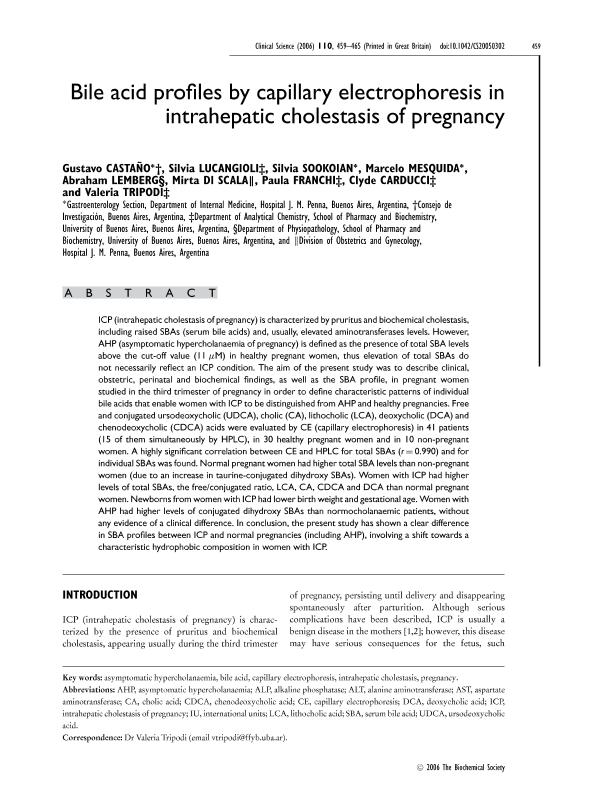Artículo
Bile acid profiles by capillary electrophoresis in intrahepatic cholestasis of pregnancy
Castaño, Gustavo Osvaldo; Lucangioli, Silvia Edith ; Sookoian, Silvia Cristina
; Sookoian, Silvia Cristina ; Mesquida, Marcelo; Lemberg, Abraham; Di Scala, Mirta; Franchi, Paula; Carducci, Clyde Nora; Tripodi, Valeria Paula
; Mesquida, Marcelo; Lemberg, Abraham; Di Scala, Mirta; Franchi, Paula; Carducci, Clyde Nora; Tripodi, Valeria Paula
 ; Sookoian, Silvia Cristina
; Sookoian, Silvia Cristina ; Mesquida, Marcelo; Lemberg, Abraham; Di Scala, Mirta; Franchi, Paula; Carducci, Clyde Nora; Tripodi, Valeria Paula
; Mesquida, Marcelo; Lemberg, Abraham; Di Scala, Mirta; Franchi, Paula; Carducci, Clyde Nora; Tripodi, Valeria Paula
Fecha de publicación:
03/2006
Editorial:
Portland Press
Revista:
Clinical Science
ISSN:
0143-5221
Idioma:
Inglés
Tipo de recurso:
Artículo publicado
Clasificación temática:
Resumen
ICP (Intrahepatic cholestasis of pregnancy) is characterized by pruritus and biochemical cholestasis, including raised SBAs (serum bile acids) and, usually, elevated aminotransferases levels. However, AHP (asymptomatic hypercholanemia of pregnancy) is defined as the presence of total SBA levels above the cutoff value (11 µM) in healthy pregnant women thus, elevations of total SBA not necessarily reflects an ICP condition. The aim of the present study was to describe clinical, obstetrical, perinatal and biochemical findings, as well as the SBA profile, in pregnant women studied in the third trimester of pregnancies in order to define characteristic patterns of individual bile acids that enable women with ICP to be distinguished from AHP and healthy pregnancies. Free and conjugated ursodeoxycholic (UDCA), cholic (CA), lithocholic (LCA), deoxycholic (DCA) and chenodeoxycholic (CDCA) acids were evaluated by CE (capillary electrophoresis) in 41 patients (15 of them simultaneously by HPLC), in 30 healthy pregnant women and in 10 non-pregnant women. A highly significant correlation between CE and HPLC for total SBAs (r 0.990) and for individual SBAs was found. Normal pregnant women had higher total SBA levels than non-pregnant women (due to an increase in taurine conjugated di-hydroxi-SBAs). Women with ICP had higher levels of total SBAs, the free/conjugated ratio, LCA, CA, CDCA and DCA than normal pregnant women. Newborns from women with ICP had lower birth weight and gestational-age. Women with AHP had higher levels of conjugated di-hydroxi SBAs than normocholanemic patients, without any evidence of a clinical difference. In conclusion, the present study had shown a clear difference in SBA profiles between ICP and normal pregnancies (including AHP), involving a shift towards a characteristic hydrophobic composition in women with ICP. Intrahepatic cholestasis of pregnancy (ICP) is characterized by pruritus and biochemical cholestasis, including raised serum bile acids (SBA) and, usually, elevated aminotransferases levels. However, asymptomatic hypercholanemia of pregnancy (AHP) is defined as the presence of total SBA levels above the cutoff value (11 µM) in healthy pregnant women so, elevations of total SBA not necessarily reflects an ICP condition. The aim of this work is to describe clinical, obstetrical, perinatal and biochemical findings as well as the SBA profile in pregnant women studied in the third trimester of their pregnancies in order to define characteristic patterns of individual bile acids that enable to distinguish women with ICP from AHP and healthy pregnancies. Free and conjugated ursodeoxycholic (UDCA), cholic (CA), lithocholic (LCA), deoxycholic (DCA) and chenodeoxycholic (CDCA) acids were evaluated by capillary electrophoresis (CE) in 41 patients (15 of them simultaneously by HPLC), in 30 healthy pregnant women and in 10 non-pregnant women. A highly significant correlation between CE and HPLC for total SBA (r 0.990) and for individual SBA was found. Normal pregnant women had higher total SBA levels than non-pregnant women (due to an increase in taurine conjugated di-hydroxi-SBA). ICP patients showed higher values of total SBA, free/conjugated ratio, LCA, CA, CDCA and DCA than normal pregnant women. Newborns of ICP patients showed lower birth weight and gestational-age. Women with AHP showed higher levels of conjugated di-hydroxi SBA than normocholanemic patients, without any evidence of clinical difference. This study showed a clear difference in SBA profiles between ICP and normal pregnancies (including AHP) involving a shift towards a characteristic hydrophobic composition in ICP patients.
Archivos asociados
Licencia
Identificadores
Colecciones
Articulos(IDIM)
Articulos de INST.DE INVEST.MEDICAS
Articulos de INST.DE INVEST.MEDICAS
Citación
Castaño, Gustavo Osvaldo; Lucangioli, Silvia Edith; Sookoian, Silvia Cristina; Mesquida, Marcelo; Lemberg, Abraham; et al.; Bile acid profiles by capillary electrophoresis in intrahepatic cholestasis of pregnancy; Portland Press; Clinical Science; 110; 4; 3-2006; 459-465
Compartir
Altmétricas



